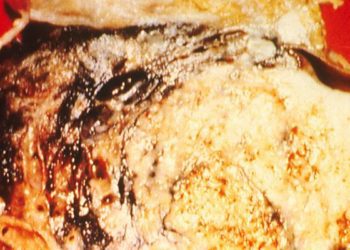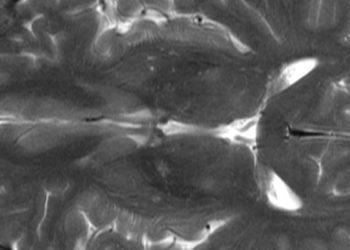2 Minute Medicine Rewind July 20, 2020
Death, discharge and arrhythmias among patients with COVID-19 and cardiac injury
1. In patients positive for COVID-19 suffering cardiac injury, cardiac troponin (cTnI) levels were associated with poor survival, with peak cTnI levels shown to predict the need for invasive ventilation.
Evidence Rating Level: 2 (Good)
Reports show that patients with COVID-19-associated pneumonia and cardiac injury experience poor outcomes, but whether they were discharged or died remained uncharacterized as the pandemic was ongoing. Additionally, the arrhythmia burden in those admitted to the ICU was estimated at 44.4%, but the nature of these arrhythmias was also largely unknown. Studying data from the Wuhan outbreak, which had run its full course, could allow for identification of independent predictors of poor outcomes (ie need for invasive ventilation) and characterization of these arrhythmias.This retrospective cohort study included 1284 patients with severe COVID-19, defined as viral-positive patients who had CT-confirmed pneumonia, that were admitted to Tongji Hospital in Wuhan, China from Jan 29 to March 8, 2020. Of those, 1159 patients had their cTNI measured within 72 hours of admission and 170 patients with cardiac injury (cTNI >26.2pg/mL) were included (n=49 discharged alive, median 61.5yo, 16% male, onset of illness median 11 days; n=121 died, median 64yo, 77% male, onset of illness median 11 days) were included. Those patients with cardiac injury had a mortality rate over 10 times higher than those without elevated cTNI (71.2% vs 6.6%, p<0.001). Even after adjusting for age, sex, and usage of QT-prolonging medications, both initial (per 10-fold increase, HR 1.32, 95% CI 1.06-1.66) and peak cTNI levels (per 10-fold increase, HR 1.70, 95% CI 1.38-2.10) during hospital stay were associated with poor survival. Furthermore, peak cTNI levels were an independent predictor for needing invasive ventilatory support (OR 3.02, 95% CI 1.92-4.98). As well, 53 arrhythmia episodes were recorded on ECGs among 60 of the patients with cardiac injury (35 patients with atrial arrhythmias only, 2 ventricular only, 7 both), an association not previously seen with SARS or MERS. With 35 patients experiencing only atrial arrhythmias. Overall, patients who died in hospital had more dyspnea (51.2% vs 30.6%, p=0.02), a greater need for mechanical ventilation (66.9% vs 4.1%, p<0.001), and higher levels of cTNI (393.8 vs 48.5 pg/mL, p<0.001). Data on patients without cardiac injury, other than mortality, could not be accessed and whether patients developed cardiac injury past the first 72 hours after admission was not considered. Nonetheless, these findings support assessing cTNI levels in patients with COVID-19, undergoing therapy that prolongs repolarization.
One‐Year Mortality After Intensification of Outpatient Diuretic Therapy
1. Patients with heart failure may experience a nearly two-fold increase in mortality risk during the next year after an outpatient intensification of diuretic therapy.
Evidence Rating Level: 2 (Good)
Hospitalizations are associated with increased mortality risk after discharge in patients with decompensated heart failure, with intensifying diuretic therapy being one of the main interventions given during hospitalization. However, as demonstrated in the PARADIGM-HF trial [Prospective Comparison of angiotensin receptor-neprilysin inhibitor (ARNI) With angiotensin-converting enzyme inhibitor (ACEI) to Determine Impact on Global Mortality and Morbidity in Heart Failure], this intervention alone increased mortality risk in a clinical trial setting, in the absence of hospitalizations. With higher doses of loop diuretics associated with higher mortality risk, reoccurences of fluid retention treatment without hospitalization may be a frequently overlooked but important marker for heart failure progression.In this retrospective cohort study, out of 192 706 patients from the Danish National Register with incident HF diagnosed between 2001 to 2016 and who received ACEI/ARB and BB within 120 days, 74 990 patients were included (median 71yo, 36% women, 51% with ischemic heart disease, 34% AF). These patients were followed for 5 years, or until death, migration, or the end of 2017. To calculate absolute 1-year mortality risk, patients who experienced an intensification event (defined by jumps in dosage according to the DOSE trial protocol*) and those hospitalized for HF were risk set matched with two controls from the study population, who did not experience these signs of worsening. The intensification and hospitalization groups had comparable demographics, with those receiving intensification being slightly older (median age 72 vs 70yo), more frequently living in a nursing home (6 vs 4%), and less likely to be treated with an MRA (31 vs 43%). Patients experiencing an intensification event had an absolute 1-year mortality risk of 18.0% (n= 2910, HR 1.75 after first event, p<0.001) while HF hospitalization patients had 22.6% (n= 2741, HR 2.28 after first event, p<0.01), compared to 9.8% from the matched controls (n=2437, 95% CI, 9.5-10.1%). While intensification events were associated with a cumulative 8.8% incidence of HF hospitalization (95% CI, 8.0-9.6%), there remains an association between these events with a significant increase in hospitalization-free mortality. Subgroup analyses did note that among patients first diagnosed as outpatients, those younger than 70 years old and those with COPD experienced no significant difference in mortality risk subsequent intensification events and hospitalizations. These results apply to a select population of HF patients (ex. the frailest patients who did not survive 120 days past diagnosis were excluded), and there was no data on intensification events that occurred during hospitalizations, or on clinical signs and laboratory results that could have allowed for further stratified analyses. Nevertheless, these findings support reevaluating patients who experience intensification events, in addition to patients hospitalized for worsening HF, for therapeutic optimization.
*intensification event: a) newly prescribed loop diuretics of a minimum 80mg/d furosemide equivalent, b) doubled dosage of initial dose equivalent to a minimum 160mg/d of furosemide, or c) newly prescribed thiazide added to ≥160 mg/d furosemide
1. Increased expression of the protein hemopexin in stroma of patients with pancreatic ductal adenocarcinoma may be associated with lymph node metastasis.
Evidence Rating Level: 2 (Good)
Pancreatic ductal adenocarcinoma (PDAC) has a 5-year survival rate of 7% and patients with lymph node metastases (≥4) have a 25% lower 5-year survival rate than those with no metastases. Proteomics has been increasingly used clinically to identify tumor biomarkers and increasing attention is being paid to the tumor microenvironment, including the stroma.In the first step of this experimental cohort study, proteomic profiling was used to determine if there was a difference in stromal protein expression (tissue ≤2mm away from cancer cells) in PDAC patients with lymph node metastasis (≥4 lymph nodes) (n=141) compared to those without (n=42). Included patients must have had resection of their pancreatic tumor, no neoadjuvant therapy, histologically classified as PDAC, tumor size ≥20 mm that extended beyond the pancreas, and sufficient stroma. Only five patients from each group were chosen for this step. Nine proteins were identified and two were chosen to be studied, hemopexin and ferritin light chain, as they had increased expression in tissues of patients with LN metastasis (as opposed to decreased expression in patients with LN metastasis) and this correlated well with validation by immunohistochemistry. When comparing both proteins to clinicopathological parameters, only hemopexin seemed to have an association and was further discussed.Characteristics of patients chosen for clinicopathological analysis (n=163) include 79% being lymph node positive, mean tumor size 31 mm, mean LN metastasis 2.5 (for all), 89% with R0 resection margins, and median overall survival 23 months. Univariate analysis showed that hemopexin did not relate to age, sex, tumor size, UICC T and M stages and histological grade but did relate to tumor location. The hemopexin-positive group also showed higher UICC N2 staging versus N0+N1 staging (26.3% versus 7.7%, p =0.0399), higher LN ratio of positive to dissected LNs (0.12 vs 0.05, p =0.0252), and increased chance of higher tumor invasion grades for venous and lymphatic invasion as per Classification of Pancreatic Carcinoma by the Japan Pancreas Society (high-grade venous invasion v3 50.1% vs. 23.1%, p=0.0096, high-grade lymphatic invasion ly3 23.4% vs. 3.9%, p=0.0232). Further in vitro studies of the effect on hemopexin on two pancreatic cell lines, MIA PaCa-2 and Panc-1, showed increased cell migration into wound areas and higher wound-repair rates with increasing hemopexin concentration. In addition, there was greater cell migration and increased number of invading cells with the presence of hemopexin. As PDAC is known to have abundant stroma, hemopexin may become a useful oncologic biomarker for predicting increased risk of lymph node metastases in these patients.
Impact and prognosis of the expression of IFN-α among tuberculosis patients
1. Expression of IFN-α is found to be lower after successful treatment of tuberculosis.
Evidence Rating Level: 2 (Good)
Tuberculosis (TB) is an infectious disease killing over 1 million people annually worldwide, caused by the bacterium M. tuberculosis (M.tb). The immune response to TB involves T cells that express signalling proteins known as interferons (IFNs). IFN-γ, a Type II interferon, is known to combat bacterial infections. But Type I IFNs (α and β) can both bolster and hinder the mechanisms that protect against infection. Although the immune response leads to many TB infections becoming dormant, 10% of these cases develop clinical TB later on. Past studies have shown that the increase in Type I IFNs precedes clinical TB onset. This study investigated the Type I IFN levels in Indian TB patients. The blood samples of patients with active TB were analyzed before treatment, and 29% of these patients provided samples following successful treatment. Samples from the patients’ healthy household contacts (HHCs) were also analyzed. Prior to treatment, IFN-β and γ levels were comparable between TB patients and their HHCs (median fold expression for IFN-β: TB = 0.030, HHC = 0.031; for IFN-γ: TB = 0.071, HHC = 0.79). Contrastingly, IFN-α expression was 3.5 folds higher (p<0.0001) at 0.8 median fold in TB patients and 0.23 median fold in HHCs. As well, IFN-α was reduced by 3 folds in successfully treated patients, from a median fold expression of 0.37 to 0.13 (p<0.001), and IFN-β was reduced 2 folds, from 0.04 to 0.02 (p<0.001). IFN-γ was unchanged. Overall, IFN-α can be an important prognostic marker for TB, since its levels decrease dramatically after successful TB treatment.
Characterization of gut contractility and microbiota in patients with severe chronic constipation
1. Hypersensitivity to cholinergic nerve stimulation were found in colons of patients with chronic constipation, while their gut microbiota was found to resemble a typical gut microbiome.
Evidence Rating Level: 3 (Average)
Chronic constipation (CC) is a gastrointestinal condition that drastically impacts quality of life, with greater prevalence at increasing age. However, the physiological cause of this condition is relatively unknown. Past research has shown that CC patients may have smooth muscle contractions in the colon with lower frequency, amplitude, and duration. There have been mixed results regarding cholinergic innervation, with some literature showing decreased colonic cholinergic nerve activity of CC patients, and other research demonstrating hypersensitivity to cholinergic stimulation. As well, analyses on gut microbiota from constipated patients have yielded conflicting results, most likely due to different methodologies used (culture-based vs metagenomic approaches). It is also unknown if differences in gut microbiota cause CC, or if instead, these differences are a result of CC. This study aimed to analyze the contractile and microbiota characteristics of colonic tissue from CC patients. When comparing colon muscle strips from CC and non-CC patients, the circular smooth muscle from both groups showed spontaneous contractile activity, and the patterns of spontaneous contractile activity observed were comparable in both groups. In both circular and longitudinal smooth muscle, CC patient specimens exhibited higher amplitudes of evoked contractions, which suggests increased sensitivity to cholinergic nerve stimulation. For instance, in the presence of 70 mM KCl, the mean±SEM amplitude for longitudinal muscle was 0.129±0.026 in CC patients and 0.050±0.006 in the control group (p = 0.028). In circular muscle, it was 0.192±0.033 in CC patients and 0.073±0.014 in the control (p = 0.028). In the microbiota analyses, butyrate-producing genera (Coprococcus, Faecalibacterium, Roseburia) were found to be in low amounts, suggesting they were unlikely to hinder colonic motility. The genera Bifidobacterium and Lactobacillus, which are commonly found in non-CC patient guts, were not found to be less prevalent in CC patients. Furthermore, any variations in microbiota among CC patients were unaffected by age, sex, and colonic anatomy. While this study did not reveal a specific microbial culprit for chronic constipation, heightened cholinergic sensitivity in the colon may be a physiological indicator of CC.
Image: PD
©2020 2 Minute Medicine, Inc. All rights reserved. No works may be reproduced without expressed written consent from 2 Minute Medicine, Inc. Inquire about licensing here. No article should be construed as medical advice and is not intended as such by the authors or by 2 Minute Medicine, Inc.








